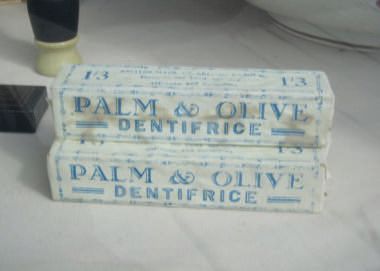‘You’re soaking in it’
Evan Zabawski | TLT From the Editor August 2013
A not-so-secret ingredient once used as a lubricant.

To figure out the secret moisturizing ingredients, look no further than the name.
www.canstockphoto.com
I JUST HAD AN EPIPHANY while visiting a living historical village. It was there I saw a few boxes of old toothpaste labeled Palm & Olive Dentifrice in the drugstore’s window display. This triggered a memory of Madge, the manicurist from a popular ad campaign that ran from 1966 to 1992.
Madge would recommend using Palmolive dishwashing soap, since it softens hands as you wash. The customer, who has been soaking her hands in a green solution, asks if it is mild. Madge would amaze with the classic line, “You’re soaking in it.” To figure out the secret moisturizing ingredients, look no further than the name.
In 1898, Mr. B.J. Johnson’s eponymous company in Milwaukee was making soap from palm oil and olive oil. The product proved so popular the company was renamed Palmolive. In 1926, Palmolive merged with Missouri-based Peet Brothers, another soap manufacturer. Two years later, Palmolive-Peet merged with Colgate to become the Colgate-Palmolive-Peet Co., a name that lasted until 1953 when Peet was dropped.
By that time, Colgate-Palmolive was in fierce competition with the largest soap manufacturer, Proctor & Gamble (Ivory) and competed for ad space when sponsoring many of the episodic dramas playing on both radio and television. Other sponsors, Dial Corp. and Lever Brothers (Sunlight), were also soap manufacturers, so these shows became known as “soap operas.”
These soaps are all manufactured with palm oil, or from saponification of the palm oil to form sodium palmate, or with sodium palm kernelate (a natural salt derived from palm kernel oil). Throughout history, palm oil has had many other uses.
Ancient Egyptians are believed to have used it as cooking oil and as an unguent (oilier, less viscous form of ointment) as far back as 3,000 BC. During the Industrial Revolution, it was used for candle-making and as machine oil. The invention of the hydrogenation of oils and fats in 1902 allowed manufacturers to make margarine.
In 1943, derivatives of palmitic acid were combined with naphtha to form a deadly incendiary device. The ingredients for the gelling agent, NAphthenic acid and PALMitic acid, gave rise to its name. Even though the formulation was changed in 1949, its well-known name has carried on to newer formulations.
After World War II, further improvements in palm-oil refining technology and transport methods made it possible to use largely unhydrogenated palm oil in Western food products. Just check one of your favorite packaged foods and you are likely to find some variant of palm oil as a primary ingredient, though packaging laws may allow for it to be simply referred to as vegetable oil.
Palm oil is often used to derive sodium laureth sulfate and sodium lauryl sulfate—the surfactants found in almost any foaming personal care, cosmetic or cleaning product, which I spoke so highly of in my July 2012 column. The future sees some serious potential for palm oil to return as a lubricant, or possibly in the creation of bio-diesel fuel.
I certainly never realized that palm oil played such a central role in so many products. I’m a little embarrassed I never before made the connection when I was washing dishes. As for the box that set me off on this topic, it put one last thought into my mind. “Dentifrice,” which is an Old French word, comes from the Latin dentifricium from
dent- , dens tooth +
fricāre to rub. Just think, if Dr. Peter Jost (who coined the word “tribology”) had used Latin instead of Greek, we might have become the Society of Fricarologists and Lubrication Engineers!
 Evan Zabawski, CLS, is a reliability specialist in Calgary, Alberta, Canada. You can reach him at evan.zabawski@gmail.com
Evan Zabawski, CLS, is a reliability specialist in Calgary, Alberta, Canada. You can reach him at evan.zabawski@gmail.com.